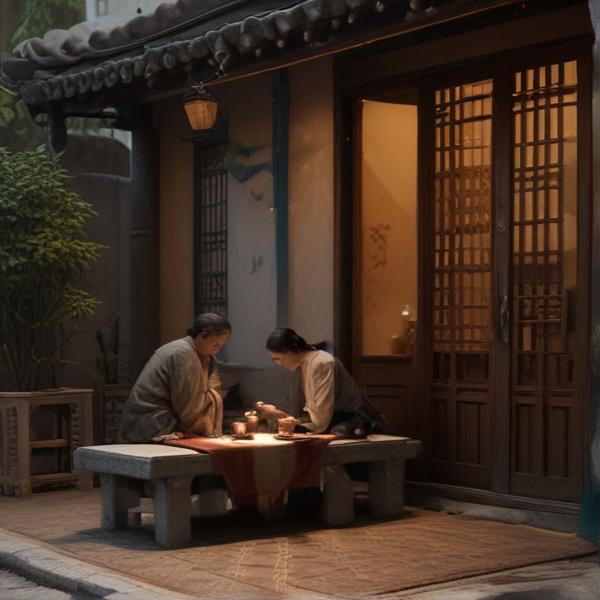基本信息 (Basic Information)
含义与用法 (Meanings & Usage)
中文核心释义 (Core Chinese Meaning): 悠,表示长久、闲适、深远或缓慢的意思,常用来形容时间、心情等祥和、沉静。
英文核心释义 (Core English Meaning): long and leisurely; calm; profound or distant (in time or feeling); slow and relaxed.
象形意义 / 为何这么写 (Pictographic Meaning / Writing Rationale)
文言文释义 (Classical Chinese Meaning)
文言文中“悠”指心情悠远、迟缓,与现代意义相近。Similar to modern meaning: In classical Chinese, '悠' referred to a prolonged, slow or profound state of mind.
深入学习 (In-depth Study)
字源故事 (Origin Story)
字形演变 (Character Evolution)
常用词语和例句 (Common Words & Examples)
悠久 (long-standing; time-honored; of long duration)
中国有着悠久的历史。
Eng: China has a long history.
悠闲 (leisurely; relaxed)
他过着悠闲的生活。
Eng: He leads a leisurely life.
悠悠 (gentle and long (of sound or time); distant; lingering)
远处传来悠悠的钟声。
Eng: A gentle and lingering bell sound came from afar.
相关成语 (Related Idioms)
相关成语信息待补充。Related idiom information pending.
多语言翻译 (核心释义) (Translations (Core Meaning))
- French: long, tranquille, paisible
- German: lang andäuernd, ruhig, gelassen
- Spanish: largo, tranquilo, apacible
- Italian: lungo, tranquillo, sereno
- Portuguese: longo, tranquilo, sereno
- Russian: долгий, спокойный, безмятежный
- Arabic: طويل، هادئ، مريح
- Persian: دراز، آرام، آسوده
- Dutch: langdurig, rustig, ontspannen
- Polish: długi, spokojny, beztroski
- Vietnamese: lâu dài, thư thái, thảnh thơi
- Ukrainian: довгий, спокійний, безтурботний
视频学习资源 (Video Learning Resources)
通过以下链接在热门视频网站搜索 "悠" 的更多讲解:
Search for more explanations of "悠" on popular video sites:
- 在 Bilibili.com 搜索 "悠 字源 说文解字" (Search on Bilibili)
- 在 YouTube.com 搜索 "悠 character origin etymology" (Search on YouTube)
网络参考 (Web References for "悠") ()
网络内容摘要 (Web Content Summary):
```html核心含义与字源:“悠”(拼音:yōu)是常用汉字,最早见于春秋时期的文字。这个字是形声字,左边“心”表示与内心情感有关,右边“攸”表示读音。最初的含义是忧思、绵长的思念,后来引申为长久、久远,也可以表示悠闲、自在。 Core meaning and origin: “悠” (pinyin: yōu) is a commonly used Chinese character that first appeared in writings from the Spring and Autumn period. It is a phono-semantic compound character: the left side “心” symbolizes emotion/heart, while “攸” gives the sound. The original meaning is deep longing or prolonged thoughts. Later, it extended to mean long-lasting, distant in time, and a sense of leisure or ease.
文化与有趣用法:“悠”不仅用于表达长久和思念,还经常用于描绘轻松、自在的状态,比如“悠闲”、“悠然自得”。在口语中,“悠”还有悬空晃动的意思,如“悠扬”(声音舒展动听)和“忽悠”(口语,意为哄骗或不实之言)。 Cultural and interesting usage: Aside from its core meanings, “悠” frequently appears in terms describing a relaxed, calm state, such as “悠闲” (leisurely) and “悠然自得” (at ease and content). In spoken Chinese, it also describes swinging or swaying motions, as in “悠扬” (melodious) and “忽悠” (to bluff or deceive in a casual way).
- 常用词语:悠长、悠久、悠然、悠扬、悠闲、忽悠 Common words: 悠长 (long-lasting), 悠久 (ancient; long history), 悠然 (at ease), 悠扬 (melodious), 悠闲 (leisurely), 忽悠 (to bluff/trick)
易混淆点:“悠”与“忧”(worry)形近且音近,但意义不同,“悠”重在悠长或悠闲,“忧”侧重担忧、忧虑。 Common confusion: “悠” is visually and phonetically similar to “忧” (worry), but “悠” relates to length, ease, or swaying, while “忧” is associated with anxiety or concern.
```悠 字源 字形演变 甲骨文 金文 说文小篆 - 百答知识
本页面为您讲解汉字"悠"从古到今的字形演变过程,以及汉字"悠"甲骨文 、金文、说文小篆、六书通的各个时代不同的写法。 ... 2500个常用字之一。 造字法为形声:从心、攸声。基本汉字。 悠 拼音:yōu注音:ㄧㄡ部首:心,部外笔画:7,总笔画:11 ...
悠(汉语汉字)_百度百科
悠(拼音:yōu),汉语一级通用规范汉字(常用字)。此字始见于春秋文字。"悠"是形声字,从心,攸(yōu)声。本义为忧思、绵长的思念。由绵长的思念引申为长远、久远。又表示闲适的样子如"悠闲"、"悠然自得"。在口语中还指悬空晃动,如"悠扬"、"忽悠"等。
更多图片 (悠 More Images) ()
